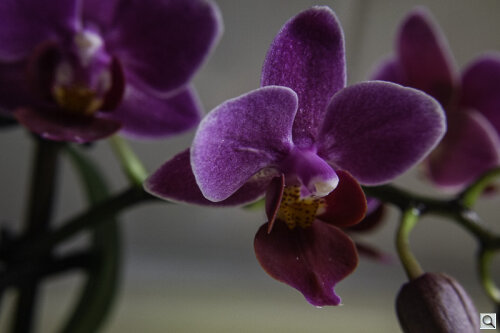Photo Corners headlinesarchivemikepasini.com
![]()
A S C R A P B O O K O F S O L U T I O N S F O R T H E P H O T O G R A P H E R
![]()
Enhancing the enjoyment of taking pictures with news that matters, features that entertain and images that delight. Published frequently.
Friday Slide Show: Phalaenopsis



16 August 2024
There is probably no generic hospital gift that is without a downside (we've made a study of them). Books and magazines require the ability to focus or at least flip pages. Flowers are pretty but die. Plants require attention.
The patient often isn't in a position to follow up on the required demands. They are, after all, disabled in some way.
So anything that require attention is going to fall flat if not fail.
Trader Joe's now and then sells Phalaenopsis, a southeast orchid known as the mother orchid. It's relatively easy to care for, is compact and lives for 20 years.
It takes up very little space on a hospital room night stand, requires very little water and would seem ideal expect that it takes up space on a night stand and has to be watered.
A niece gave one to Mom a year ago this month and never returned to water it. We watched the flowers shrivel and fall off but left it there even though it had become nothing more than a stalk.
One day a roommate had two friends visit. They brought her a Phalaenopsis. One of them told her to put one ice cube a month in the orchid "even though it will lose its flowers and become a stalk."
"Oh," we said, "so my mother’s isn’t dead?" No, where there are still green leaves, "there is hope," the orchid expert said encouragingly. So we started watering it a bit and in December we brought it home.
We'd been watering the two orchids at Mom's home once a week and they had recently bloomed so we followed the same routine with the Phalaenopsis.
This avoided the shock of an ice cube. But it left the issue of fertilizer up in the air. The little card that came with the plant recommended fertilizing once a month. And we had some fertilizer laying around. But another friend had said she never gives up on an orchid and never fertilizes them.
So we thought we'd play it be ear.
We watched as the one green leaf was joined by a new one and then two more began to grow where once there was only a dry stalk. And then one day a purple stalk shot up from the middle of them and sprouted buds. One by one the buds opened.
It had taken a year.
The blooms last two to three months, apparently. We've resolved to fertilize this orchid every month to see if we can keep them coming.
